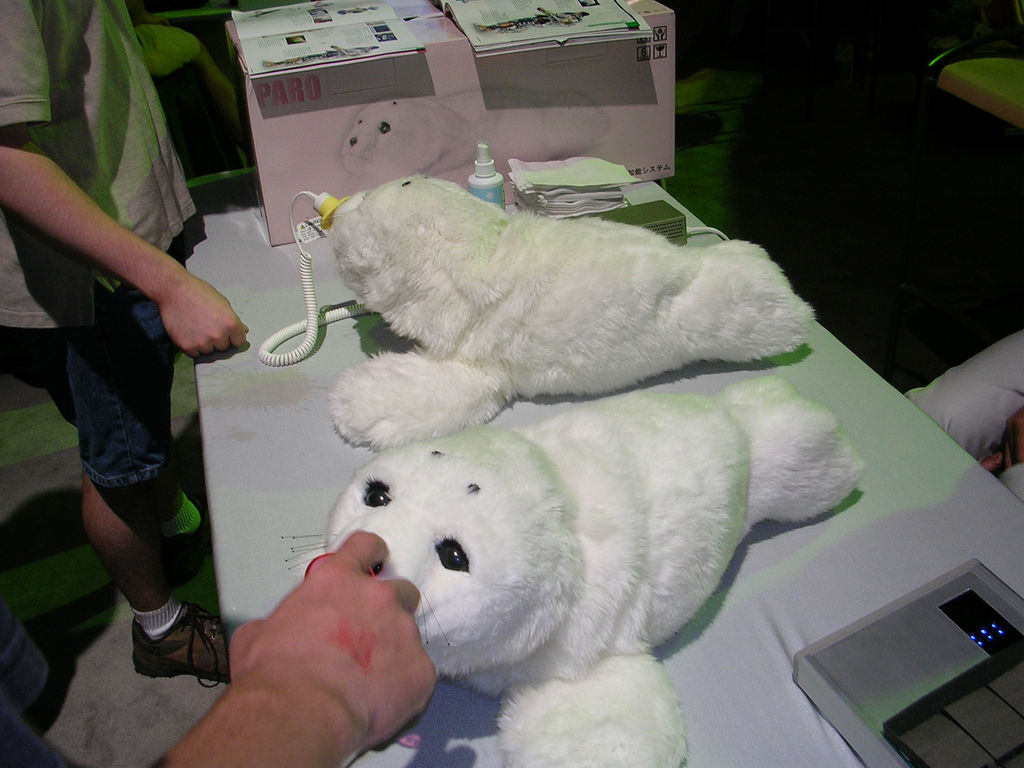Virtue Circuits: Can Robots Embody the Fruits of the Spirit?
This article is part of an ongoing series exploring the intersection of Christian theology and robotics. These reflections are shaping my next book on the theology of robotics, and I’d love your insights, reflections, and feedback as we explore together!
Robots are no longer just distant sci-fi characters or industrial assembly-line workers. Increasingly, they are our everyday companions: delivering groceries, driving cars, caring for elderly relatives, even teaching our children. As these machines become more intimately integrated into human life, the questions we ask about their roles deepen—not just practically or ethically, but spiritually.
So here’s a provocative question that caught my attention: Can robots embody the fruits of the Spirit described in Galatians 5:22–23?
In case you need a quick refresher, Paul writes:
But the fruit of the Spirit is love, joy, peace, patience, kindness, goodness, faithfulness, gentleness, self-control; against such things there is no law.
Paul sets these fruits in sharp contrast to the “works of the flesh”—things like jealousy, division, and envy. Clearly, we don’t want robots exhibiting those. But can a robot genuinely reflect something as profoundly spiritual as love, joy, or peace?
At first glance, it might seem absurd to connect something as fundamentally human and spiritual as love or joy to circuits and code. But as robots become companions and caregivers, engaging closely with our emotional and spiritual lives, it’s increasingly important to thoughtfully examine these possibilities.
Virtue: More Than Actions, More Than Code
To properly explore this, let’s clarify a key concept: virtue. Classically defined, virtue is not just correct action but a deeply ingrained habit of character—qualities formed through long practice and guided by relationships, culture, and spiritual formation.
Christian virtue ethics (influenced by Aristotle and articulated beautifully by theologians like Alasdair MacIntyre and Stanley Hauerwas) emphasizes virtue as character rather than isolated actions. Virtue emerges from an internal, transformative reality, reflecting something true about who we are, not merely what we do.
Immediately, we face an obvious problem: robots lack inner lives. They don’t experience spiritual formation or moral transformation (unless you have a particularly precocious Roomba). They don’t meaningfully exist in a culture. They’re programmed machines, bound by instructions, without freedom to genuinely develop character.
As a result, robots merely simulate virtue through programmed behaviors. But here’s an interesting question: even if robots can’t truly “be virtuous,” can their behaviors effectively model or encourage human virtue?
In robotics, we often say that we design robots to do the “4 Ds”: dull, dirty, dangerous, or delicate jobs. By doing these jobs, robots free people from things they don’t want to do, shouldn’t do, or can’t do. What if, in contrast, we thought of how robots could encourage us toward virtuous behavior?
This thought raises practical and theological questions: Can robots reflect spiritual virtues convincingly enough to inspire human virtue? Can their programmed behaviors serve as genuine catalysts for our spiritual growth?
You don’t have to fully unpack Aristotle or Hauerwas to engage this idea. But let’s hold this possibility in mind while we look at some practical examples.
Robotic Fruits? Exploring Practical Examples
Let’s explore each of these virtues in practical terms, using real-world robotics examples to anchor our reflections.
Love and Kindness
As the greatest virtue, love seems the most human, and therefore the most difficult virtue for a robot to embody. After all, love implies deep emotional connection, empathy, and selfless care. But another useful definition of love is “desiring the greatest good of the other.” In that sense, a robot might embody it after all.
Consider robots explicitly designed for caregiving, like the well-known (exceptionally cute) therapeutic robot Paro, a baby harp seal used to comfort patients in nursing homes, especially those with dementia. Paro gently responds to human touch and voices, encouraging calming interactions. Does Paro genuinely feel love? Certainly not. But by responding with consistent kindness, Paro can encourage patients and caregivers toward real expressions of care and compassion.

Imagine a robot more advanced than Paro—perhaps a humanoid like Apptronik’s Apollo or Figure’s latest robots—carefully guiding children or adults with social challenges in navigating social scenarios. These robots could gently coach emotional intelligence skills, modeling patience, empathy, and compassionate interaction. They don’t experience genuine love, but their programmed kindness can inspire humans around them toward authentic loving interactions.
Joy and Peace
Can robots help us find joy and peace? Consider your smartphone gently nudging you toward gratitude journaling, mindfulness reminders, prayer, or community gatherings. An autonomous companion robot could observe patterns in your daily behavior, identifying activities that genuinely lift your spirits, guiding you toward a more joy-filled, peaceful life. Such a robot wouldn’t have joy, but it could guide us toward habits fostering real joy in our own lives.
Peace also presents an interesting case. Here we’re considering not just absence of conflict but a deeper, relational harmony with ourselves and our communities. Autonomous vehicles like Waymo cars exemplify this vividly. These cars operate smoothly, safely, patiently—modeling responsible citizenship, respecting traffic laws, and fostering harmonious interactions with pedestrians and other drivers. Of course, they’re not “peaceful” internally, but they showcase peaceful integration into human life, possibly inspiring humans to do the same.
Could a robot also explicitly guide people toward greater personal peace? Imagine a robot assistant prompting us to take short breaks for prayer or meditation, reminding us to breathe deeply during stressful interactions, or even mediating quietly during tense interpersonal situations, helping foster calmness and reconciliation. While the robot itself doesn’t experience genuine peace, it becomes a tool helping us move toward spiritual maturity and relational harmony.
Patience and Self-control
Robots demonstrate superhuman patience. They never tire of repeating instructions or waiting calmly for their next task. Consider educational robots like SoftBank’s humanoid “Pepper” patiently repeating lessons for struggling learners or rehabilitation robots guiding stroke victims through repetitive exercises day after day without complaint. Observing such boundless patience can challenge and inspire human caregivers toward greater patience themselves.
On the other hand, robots could also unintentionally foster impatience. Have you noticed yourself reaching for your phone the moment there’s a brief pause? Smartphones and computers have taught us to expect immediate responses. Yet thoughtful design—perhaps robots deliberately slowing certain interactions or explicitly coaching patience—could help us grow spiritually and relationally. Autonomous vehicles that consistently choose safety and caution over speed explicitly model self-control and patience, virtues crucially needed in human communities.
Gentleness, Goodness, and Faithfulness
Gentleness isn’t simply physical softness, but a relational sensitivity and humility. Surgical robots (like the widely-used Da Vinci surgical system) demonstrate precise gentleness, performing operations with extraordinary care and accuracy. Similarly, robots in elder care settings can lift and transfer vulnerable patients with more gentleness than human caregivers might consistently manage.
Faithfulness—loyalty and consistent reliability—is another compelling robotic virtue. Disaster-response robots faithfully execute dangerous rescues in hazardous environments, returning repeatedly without hesitation. Roomba vacuums reliably (and tirelessly!) clean our floors day after day, modeling unwavering dependability. Their actions vividly illustrate reliability—albeit in a simple way—that we deeply value.
These behaviors, though programmed, vividly reflect virtues we deeply admire and may even inspire us toward greater faithfulness and gentleness ourselves.
Catalysts for Human Virtue: Robots as Coaches and Guides?
While robots might convincingly model certain virtues, their greatest spiritual potential might lie in how they encourage us toward genuine virtue ourselves. A robot explicitly prompting acts of compassion, gratitude, and patience can help shape our spiritual habits. Consider a sophisticated home companion robot reminding family members to engage in thoughtful acts of kindness: “Why not take a moment to thank your spouse?” or “Remember how much joy you found yesterday in helping your neighbor?” I can imagine these reminders irritating me—but that probably just indicates how much I need them.
Yet we must clearly recognize ethical and spiritual boundaries. Robots must never become substitutes for genuine human relationships or spiritual experiences. Remember, we should aim for robots to do dull, dirty, dangerous, and delicate work—relational work requires relational beings. However, robots can serve as catalysts, enriching environments where human virtue naturally thrives. Their presence can consistently reinforce human dignity and authentic spiritual relationships, never diminishing our unique image-bearing humanity.
Ethical and Theological Boundaries
Exploring robotic virtues naturally raises ethical and theological concerns. Robots simulating virtue too convincingly could blur crucial distinctions between genuine spiritual virtue and mechanical mimicry. Clear ethical guidelines are necessary:
- Which virtues can robots credibly reflect without misleading us?
- How do we prevent robots from replacing rather than enhancing genuine human spiritual growth?
- How do we ensure that robots respect fundamental human dignity and autonomy?
Designers bear profound responsibility here. Thoughtful, careful design can ensure robots serve human spiritual and relational flourishing rather than undermining it.
Toward a Thoughtful Robotics
This exploration doesn’t yield simple answers, but it’s profoundly worthwhile. As we continue blending technology with daily life, our reflections must remain nuanced, thoughtful, and grounded in biblical truth.
And that’s where you come in.
Your Turn—Help Shape This Conversation
I’m deeply interested in your perspectives. This post represents early thoughts from a larger project on the theology of robotics. Your insights will directly shape its development. Here’s what I’d love your feedback on:
- What virtues could (or couldn’t) a robot meaningfully reflect?
- Do you have experience with robots clearly influencing human virtue—positively or negatively?
- How should Christians thoughtfully approach robotics design and usage, especially concerning spiritual virtues?
- Do you see risks or opportunities I haven’t mentioned?
Please send me feedback via email. Your reflections, insights, and critiques are invaluable as we navigate this fascinating intersection of Christian theology and emerging robotics together.
Thank you for reading and participating in this ongoing discussion. Stay tuned for more posts exploring how faith, ethics, and technology intersect in a robotics-driven future.



